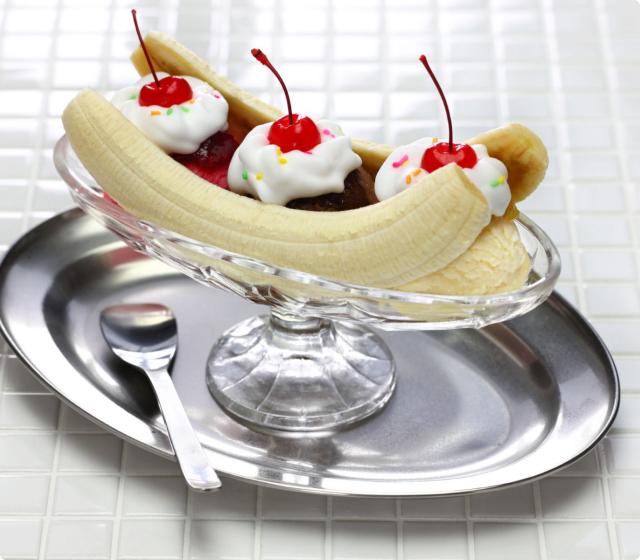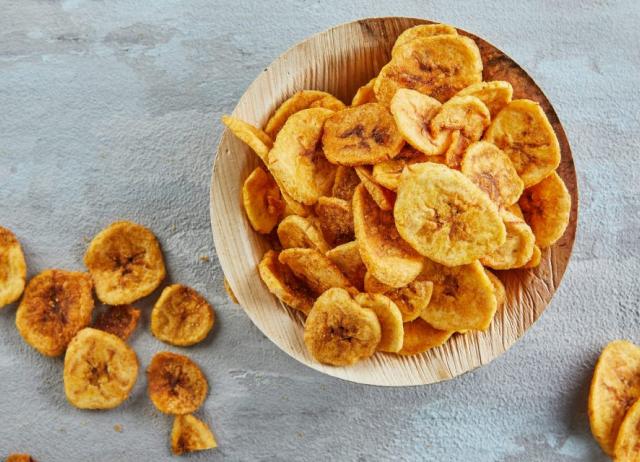

Grilled bananas. A traditional form of banana preparation on the island of Sumatra in Indonesia.
In countries with a temperate climate, bananas are most often perceived as a dessert product that is eaten fresh, peeled or used as additives in confectionery and ice cream. However, in the tropics, plantains are most often used – bananas that require preliminary heat treatment. About 80% of all cultivated bananas belong to this category.
On the islands of the Caribbean bananas are boiled in their peel while sometimes adding all kinds of seasonings – salt, vinegar, black pepper, olive oil, onions, garlic, etc. In Costa Rica, the so-called “honey” is made from them – a thick syrup formed after long-term cooking of peeled fruits.Bananas fried in olive oil are considered a common side dish for various dishes. In many countries of Latin America (Honduras, Dominican Republic, Colombia, Costa Rica, Cuba, Nicaragua, Panama, Peru, Puerto Rico, Trinidad and Tobago, Ecuador and Jamaica), a dish called maduros (ripe and peeled plantains) are cut into oblique slices 3-4 mm thick, sprinkle with salt and fry in oil until golden brown. Before consumption it is put on a plate covered with a paper towel. In Venezuela, the national dish Yo-Yo is known – a piece of soft white cheese is placed between two slices of fried bananas, and all this is fastened with a wooden toothpick.
In Peru, a common dish for every day from Platanos is cappo. The peel is removed from green plantains, boiled for about 20 minutes, after which it is smashed. The resulting puree is chappo. There are two types: regular and sweet. For a sweet option are taken mature plantains – maduros.

Chips de plátano

Chips de plátano
In Polynesia and other Pacific islands, unripe fruits are baked whole on stones. When bananas ripen, their fruits are cut into slices, coconuts or coconut cream are added, wrapped in banana leaves and baked in the oven. The Polynesians have a tradition of cooking masi – a kind of canned bananas or breadfruit, prepared in case of famine. First, banana leaves are laid at the bottom of the pit. Then the fruits, previously wrapped in heliconia leaves, are stacked in layers in the pit. The pit is covered with another layer of banana leaves and pressed down with oppression from above. The fermented mass is ready for use in a month and is stored for a year. Before consumption it is shaped into cookies or cakes and baked in an oven.
In Côte d’Ivoire, a dish called Aloco is a popular dish – plantain slices, along with tomatoes, onions and red peppers, are fried in palm oil and served with grilled fish. In West Africa, and especially in Nigeria, the Ewa dodo dish is known – in it bananas serve as a side dish for tuna or shrimp. In Ghana, bananas, with the addition of cornmeal dough, seasonings from onions, ginger and pepper, are made into fritters known as fatale. Fufu stew, eaten with soup, also contains bananas.

Banana dividida

Banana dividida
In the Philippines, the so-called “banana ketchup”, which appeared during World War II, during the Japanese occupation, when regular tomato ketchup was in short supply. It is made from banana puree with sugar, vinegar, spices and red food coloring.
In the United States the “chopped banana” dish is popular. The dish is banana slices stacked on a plate with ice cream and whipped cream on top. Such a dessert is often consumed after a “formal” dinner in a restaurant.
In addition to the banana fruit, in Bengal and Kerala, the flower of the inflorescence is also eaten either raw after dipping it in sauce, or boiled in soups and gravies (the so-called curry).
Bananas are used to make baby food, jams, muffins, surrogate coffee, ice cream and chips. Banana flour is one of the components of confectionery. Various drinks are made from the fruits, including alcoholic ones – beer and wine. Dried bananas, known as “banana figs”, can be stored for quite a long time. In addition to the fruits themselves, young shoots of plants can be eaten – for example, in India they are eaten as vegetables and added to curry sauce.